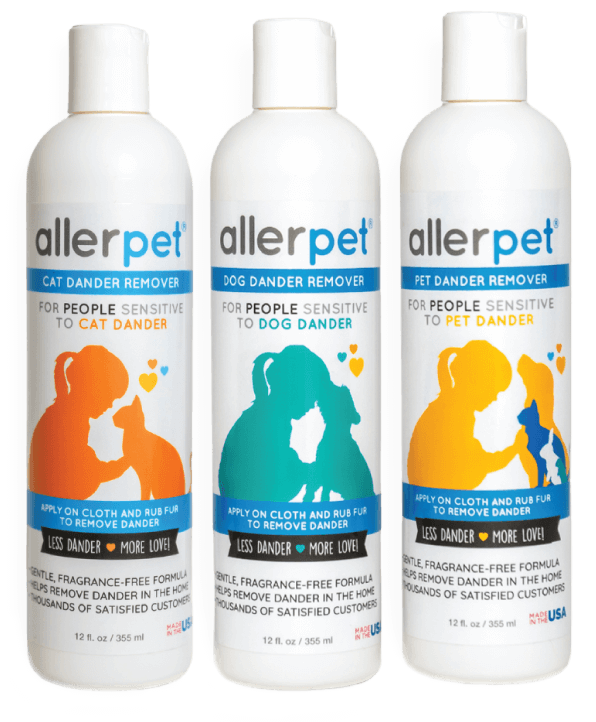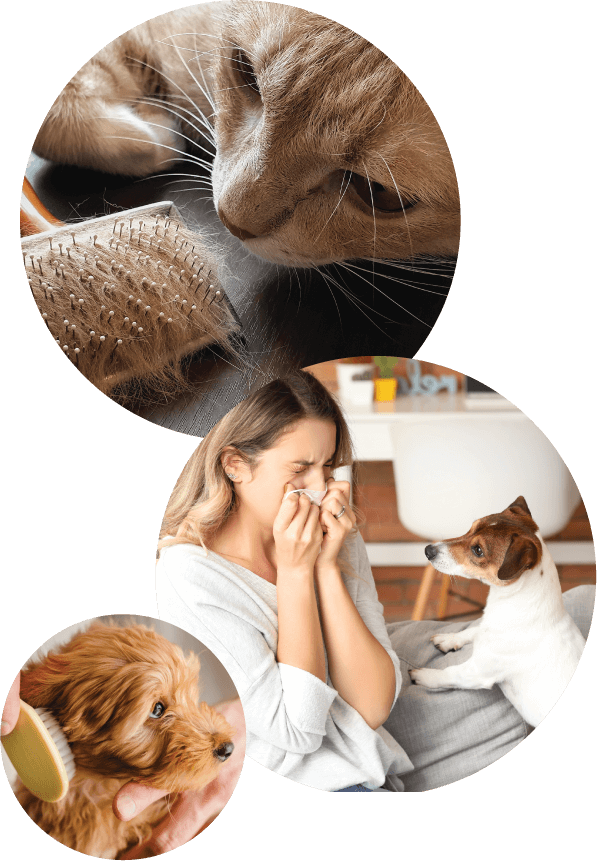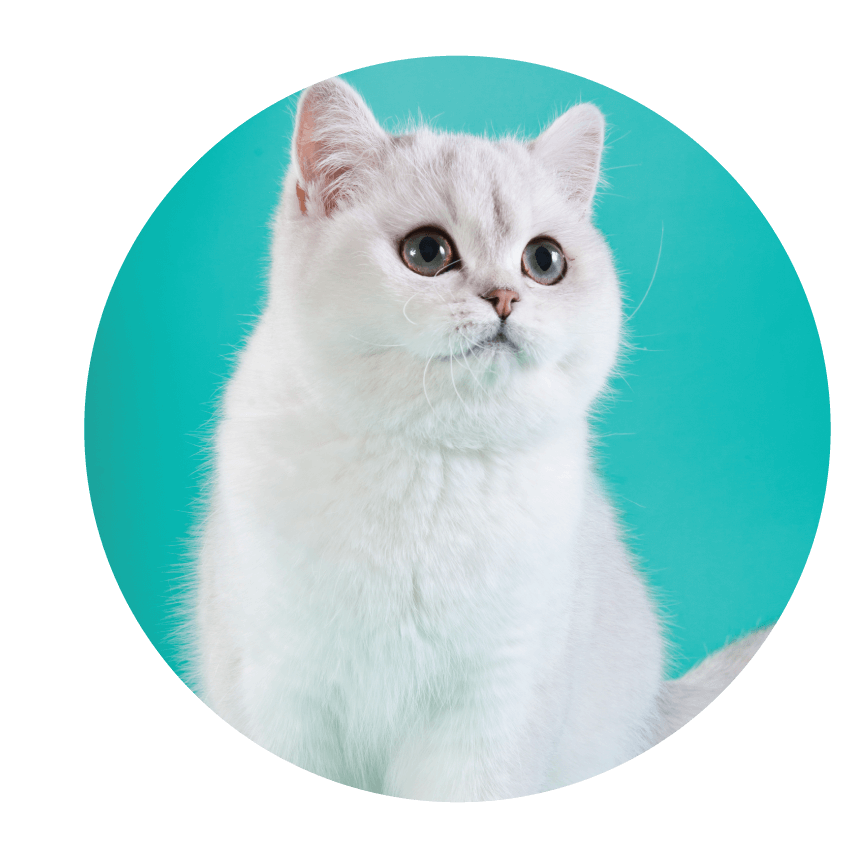Testing
& Safety

PET ALLERGIES
An Introduction To Allerpet And Pet-Related Allergens

Allerpet was created by Larry and Shirlee Kalstone as the first external product to aid in the removal of pet-related allergens from the animals of those persons who wanted pets but were unable to have them because of allergic reactions.
The first suggestion of many professionals is to give up your pet for adoption. This may well be a necessity, but Allerpet presents another possibility. There is a significant 65% to 75% chance that you may be able to keep your pet or even have a pet with a negligible or minimal chance of a reaction if you conscientiously use Allerpet as directed and do some regular (once a week) brushing or combing.
Allerpet was the first, and is still the only, product of its type to undergo formal university testing. This was done under the auspices of Bayer A.G. (Bayer aspirin) of Leverkusen, Germany, at Andhoven & Utrecht Universities in The Netherlands. The study was published in the Journal of Allergy and Clinical Immunology, January 1995, Vol. 95, Part 2, Abstract No. 727
Any animal with hair (fur) or feathers can cause allergies in humans, especially those we keep as household pets, including cats, dogs, all kinds of birds, rabbits, ferrets, gerbils, hamsters, guinea pigs and other rodents. HOWEVER, it is not the hair that is the problem . . . it is the pet-related allergens carried on the hair shafts that cause allergic reactions. Pet hair or fur is merely a carrier for the sources of pet allergens, not the allergen itself. Pets causing the most allergic reactions with humans are, in order: cats, rabbits, dogs, birds and small furry animals.
According to studies published in the Journal of Allergy and Clinical Immunology (the scientific publication of the American Academy of Allergy, Asthma and Immunology), up to 10% of the general population and 40% of allergic individuals react to cats and dogs.
The major pet-related allergens are: dander, sebaceous skin secretions (fel d 1), saliva, urine and bird feather dust.
These allergens all accomplish the same end: causing an allergic or asthmatic reaction when they are inhaled into your lungs. Pet allergens, particularly those of cats, are infinitesimally tiny in size, literally invisible to the human eye. They are extremely light weight, circulating on air currents throughout the house, floating in the air for hours before eventually settling into carpeting, bedding, upholstered furniture, rough-textured fabrics and wall coverings, heating ducts and air conditioners, and anything else with which they come into contact.
They also enter the environment on contaminated hair that pets shed, particularly when they are being stroked or groomed, when they shake, wag their tails, jump on chairs or a sofa, play indoors or rub against objects. Once these allergens do settle, sitting on furniture, vacuuming or walking on carpets, fluffing cushions or the pet’s bedding, raising or lowering the blinds, or opening drapes can cause tremendous amounts of pet allergens to billow into the air once again.

The Major Pet-Related Allergens
Dander
Pets constantly shed dander (dead skin scales, similar to only much smaller than dandruff on a human scalp)) as their epidermis, or outer layer of skin turns over or regenerates itself. The epidermis is made up of multiple thin layers which are constantly pushing upward from the deepest level of the epidermis to replace the cells above. As this process takes place, usually about every 21 days, the outer, or old dead cells, flake off the skin and into the environment as dander.
Most of these allergens are extremely small, requiring a high power microscope or chemistry to discern them. With millions or billions of them floating around a room, no one would ever know that they are even there . . . except for allergy sufferers. After they circulate in the air, they cling to drapes, furniture and wall coverings. If a dog or cat has been in the family for a period of time, some of each of its allergens will have permeated the house.
Unfortunately, there are very few hypoallergenic animals . . . cats or dogs.
Occasionally, a litter of cats or dogs will have a kitten or puppy that produces less dander, but this is a rarity and not reproducible by breeding. It just happens and will not be known until an allergic person happens to pick it up and have only a mild reaction.
Incidentally, there are no breeds of dogs or cats that do not produce allergenic pet dander, although, some do release more dander than others.
Sebaceous Gland Secretions (fel d 1)
The primary cat allergen is fel d 1, a glycoprotein that is secreted by the sebaceous glands. These secretions from the sebaceous glands of the skin are located at the base of the hair follicles and are oily lubricants that keep the skin supple. They are deposited on the hairs inside the follicles and brought up to the surface of the skin along the shaft, where they dry on the hair, flake off and become airborne as microscopic particles. The sebaceous anal glands as well as the salivary glands (see below) are also involved in allergen production.
Published studies show that fel d 1 is associated with small particles that remain airborne for long periods of time. When it does settle, fel d 1 is particularly “sticky,” clinging stubbornly to clothing, furniture, drapes, carpets and walls. fel d 1 is the most potent of all pet-related allergens and, for this reason, some people cannot enter a house or apartment where a cat lives without rapidly developing symptoms.
Saliva
Saliva is another major allergen of all pets. fel d 1 is also found in saliva and is especially potent when one is allergic to cats and/or rabbits. Cats groom themselves repeatedly by licking their fur with their tongues. Unfortunately, with each lick of their tongues, large amounts of saliva is deposited on the hair, which then dries, flakes off and becomes airborne to trigger allergic symptoms. Like cats, rabbits are fastidiously clean animals and they, too, groom themselves by licking and depositing saliva on their fur.
Urine
Urinary secretions are frequently deposited on the hair, especially on long-coated pets where, if not cleansed away, will dry on the hair and flake off to circulate in the environment. Urine is the major allergen for the small members of the rodent family: gerbils, hamsters, rats and mice.
Feather Dust From Birds
The major bird allergen is derived from their feathers. When birds preen themselves and flutter their wings, no matter how small they may be, they shake feather dust into the air in and around their cages. There are a few species of parrots which produce significant amounts of feather dander called powder. These birds … Cockatiels, Cockatoos and African Grays … are called “powder down birds.” They may cause more problems for “bird-allergic” people because they can produce enough powder to coat the furniture and floors of the room in which they are caged on an almost daily basis. Unfortunately, this dust is so tiny that it spreads quickly and circulates throughout the house.
ALLERPET TESTING
Allerpet Anecdotal Testing
Anecdotal Testing of Allerpet commenced in April of 1985. The study lasted over three years and involved 168 individuals, all of whom were either allergic to their pets or had someone in their household who was. All individuals in the study told us that they were experiencing allergic reactions with varying degrees of discomfort. All had seen an allergist at least once during the previous year. All had either cats or dogs as their primary pet. Many also had rabbits, birds, or small furry animals as secondary pets. All of their statements were accepted at face value.
The following instructions were given:
For the first application, the pet was to be brushed or combed to remove as much loose hair as possible, preferably by someone other than the allergic person. A washcloth or sponge was to be lightly wetted (not saturated) with Allerpet and thoroughly wiped over the animal, both with and against the lay of the hair. Particular attention was to be paid to the area surrounding the genitalia and other areas that the pet tends to self-clean excessively. If the pet was small enough, this procedure could be accomplished while it sat on a towel in the owner’s lap. It was not necessary for the animal to be saturated, just dampened to the skin.
Generally, a once-a-week application would be sufficient for most individuals, but Allerpet could be used as often as necessary without any fear of adverse reactions. Allerpet is non-toxic and completely safe. Birds had their feathers misted while in their cages every 2 or 3 days.
Information gathering was casual, but well documented. All individuals were talked to every three to four weeks; their comments noted; and their responses channeled into three broad categories:
CATEGORY 1
Noticed a significant improvement in their ability to tolerate their pet.
Primary dog owners: 95 out of 114
83%
Primary cat owners: 46 out of 54
85%
Dog & cat owners: 18 out of 22
82%
CATEGORY 2
Did not notice any particular difference.
Primary dog owners: 19 out of 114
17%
Primary cat owners: 8 out of 54
15%
Dog & cat owners: 4 out of 22
18%
CATEGORY 3
Noticed a significant improvement but stopped because of too much effort.
Primary dog owners: 9 out of 95
09%
Primary cat owners: 3 out of 46
02%
Throughout this study, a consistent 80 to 85 percent of those participating expressed a significant improvement in their ability to tolerate their pets. This high success rate is not inconsistent with many of papers that have been published on the subject of aeroallergens over the last few years.
Removal of the allergens from an animal before they have a chance to become airborne is the easiest, quickest and most certain way to reduce the environmental load of pet-related allergens. This is especially true of the Fel d1 allergen which remains airborne for such protracted periods of time. When the first steps to minimize the build-up of pet-related allergens into the environment are taken, Allerpet should be seriously considered as an integral part of the solution.

Allerpet University Study

Under the sponsorship of Bayer AG of Germany, extensive formal testing of Allerpet was completed at Utrecht University in the Netherlands (An abstract of this study was presented at the American Academy of Allergy and Immunology meeting in New York in February of 1995). Based upon the successful conclusion of this testing, Bayer AG, one of the world’s leading pharmaceutical and chemical companies, manufacturer of human pharmaceuticals including Bayer Aspirin and veterinary medical products such as Baytril, Pro-Spot, Tiguvon and Drontral, contracted for the distribution of Allerpet in many countries of the world, excluding the USA.
Allerpet is a product for people who are allergic to pets… 15 to 20 million in the United States alone. It is a solution that reduces the volume of cat allergens contained in house dust by a significant 50% and reduces both Fel d1 and dander on the animal’s fur and skin by eliminating them at their source. By reducing the amount of animal dander that gets into the air, an allergy sufferer’s ability to comfortably tolerate their pet is markedly increased. Allerpet is effective for approximately 80 to 85% of those who use it. The complete treatment consists of lightly wetting a washcloth with Allerpet and ‘dry washing’ the animal once a week … and brushing or combing it occasionally to remove dead hair. The process is so easy that it can be done with the pet in the owner’s lap.
The premise behind Allerpet is that the cleansing of the pet-related allergens from the animal’s fur and skin, before they have had a chance to enter the environment of the allergic person, will allow the sufferer’s environmental allergen load to fall within acceptable levels.
Currently, the treatment of choice for most patients who are allergic to animals is complete avoidance. Unfortunately, this treatment is not always practical. Intense emotional issues surface when people are told to give up their pets, being especially traumatic when several children are involved and only one is allergic. Indicative of this are the large numbers of persons, perhaps as high as 65%, who keep their pets in spite of being told to give them up.
Fel d1, commonly referred to as the ‘cat allergen’, is generally thought to be the sensitizer most responsible for cat allergies. Deposited on the fur from secretions of the sebaceous glands and during the cat’s self-cleaning process, it dries, flakes off, and is released into the air to become part of the total environment. Unlike the larger dander, dust and pollen allergens that settle to the ground within minutes, the Fel d1 allergen is so minute (as small as 2.5 microns) that it remains airborne for extended periods of time, thereby enabling it to be inhaled deeply into the lungs. Dander is also present on all cats and does cause reactions, but it is the Fel d1 that is the real issue.


Dogs do not present the same problems as cats. Dander, or scaling, is usually considered to be the major source of allergic reactions to dogs. Individuals, while sensitive to it, are not as violently reactive as they are to the Fel d1 of cats. Studies show that the proteins of the saliva and urine are also major sources of allergic reactions to dogs.
Contrary to popular belief, breed-specific allergens have never been found that differentiate the allergenicity of one breed of cat or dog versus another. A given animal within a specific breed may cause allergic reactions, while another of the same breed (or even litter) will not. There are, however, a few canine breeds, including Cocker Spaniels, German Shepherds and Doberman Pinschers that are prone to seborrhea and consequently shed far more dander than others. Their epidermal turnover of approximately every 3 to 5 days instead of the normal average of 21 can cause an allergen overload of the environment.
Allerpet Study Abstract
American Academy of Allergy and Immunology March 1995 Annual Meeting LGH Koren, E Janssen, A Willemse, DVM, PhD, Eindhoven & Utrecht, Netherlands
Many cat allergics persist in keeping cats. Attempts to reduce cat allergen (Fel d1) exposure in dwellings include the use of air cleaners, vacuum cleaners and frequent washings. None of these methods are completely effective and practical for everyday use. A more feasible way to reduce Fel d1 exposure was developed by the Allerpet Company.
In this study we have tested the efficacy of this measure in a furnished laboratory room. Fel d1 content was measured on the cats’ fur, in the air and in the settled dust. Fel d I assessments by monoclonal ELISA and RAST were influenced by the presence of Allerpet. Polyclonal RIA’s appeared reliable. Extractable Fel d1 from the cat’s fur after two treatments decreased in all cases. The Fel d1 content of dust from the carpeting on which three cats had lived for 2 weeks was compared to carpet dust where the same cats lived on before treatment. Each of two series of tests showed a reduction in Fel d1 of approximately 50% (20*103 to 60*103 Fel d1 in respectively 100 to 150 g dust) as compared to the untreated versions. Air samplings using an Anderson sampler were not successful: The Fel d1 content in all samples remained below detection limits.
The use of Allerpet indicates that a decrease in the load of Fel d1 in the settled dust of the dwelling will be obtained.
The consequences of an accumulation of Allerpet/Fel d1 complexes in furnishings should be examined further. Whether the decrease in allergen is sufficient to reduce symptoms in a specific cat allergic person will depend on the dwelling characteristics and upon the allergic person’s sensitivity.
This study of Allerpet was directed and funded by Bayer AG, Leverkusen, Germany
Allerpet Study Summary
The Effect of Allerpet/C Treatment on Fel d I Concentrations in Settled Dust, Cat Fur and Air
Controlling exposure to cat allergens is important, both in managing symptoms in allergic individuals and potentially in reducing the risk of sensitization.
Recent reports have shown that repeated washings of cats not only removes the allergen from the cat but also leads to progressive reductions in the quantity of allergens accumulating on the cat. Allerpet is a grooming emollient that cleanses the animal’s fur and skin of its dander, saliva and urine allergens and thereby reduces the volume of allergens contained on the animals.
In this study the effect of Allerpet/C treatment on Fel d1 concentrations in settled dust, fur and in air is investigated. The allergen load of a carpeted and furnished laboratory room in which cats were lodged, was determined before and after treatment of the cats with Allerpet/C. Not all allergen detection methods were applicable. Allerpet influences analytical methods with monoclonals such as RAST and ELISA. In RIA’s (with polyclonals) no influence caused by Allerpet was found.
Allerpet treatment caused a decrease in detectable Fel d 1 in settled dust of nearly 50% measured 2 weeks after treatment. Allerpet treatment diminished the Fel d1 concentration in the treatment towels. All treated cats showed a decrease of a minimum of 20% in removable Fel d1. By sampling air for 12 hours using an Anderson air sampler, no Fel d1 could be detected either before or after Allerpet/C treatment, probably since the new carpet was able to absorb most of the allergen.
In conclusion, Allerpet/C reduced concentrations in settled dust and cat fur after two weekly treatments. By reducing the allergen reservoirs in the indoor environment, Allerpet/C probably reduces health risks for cat-allergic cat owners. Future research should include a prolonged study on the allergen reduction and a more detailed investigation of the influence of Allerpet on detection methods.
Experiments
In this study, domestic cats living in a carpeted and sparsely furnished laboratory room are used to investigate the effect of Allerpet/C treatment on Fel d1 concentrations in settled dust and in air.
Also the amount of cat allergen that can be removed from the cat’s fur with Allerpet/C is examined. The following questions are investigated:
- Does Allerpet treatment decrease the level of removable Fel d1 on cat fur and skin?
- Does Allerpet treatment decrease the concentrations of Fel d1 in air and in dust?
- Is the cat’s fur negatively influenced (skin irritation/dehydration) by Allerpet treatment?
STUDY SPONSORED BY BAYER AG, LEVERKEUSEN, GERMANY